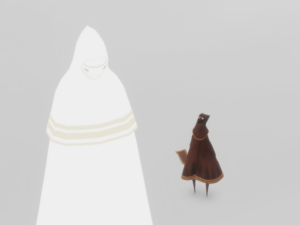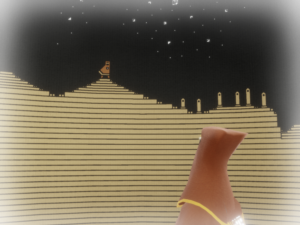Basic information
Name: Journey
Creator: Thatgamecompany & Santa Monica Studio (co-developers), Sony Computer Entertainment (publisher), Jenova Chen (director).
Platform: Originally released for PS3. I played it on my iPad.
Target audience: Anyone who enjoys emotional, cinematic, and aesthetic games. Because the skill requirement is very low, anyone from the casual to the pro gamer would fit the bill.
Formal elements
Players: Single player. I understand that characters are sometimes randomly paired with others, but unfortunately this didn’t happen to me. A lone figure trudging through a magnificent expanse evokes such feelings as humility, mystery, and awe.
Objectives: To reach the top of the mountain. The game was clever to show this in the very first (titular) cutscene.
Rules: The player is encouraged to progress towards the mountain. To this end, he may walk, slide, jump, and fly (when charged by contact with kites or cloths).
Procedures: The game can be divided into levels, separated by the player sitting down at a statue. The game will then segues into a brief cutscene encounter a large white figure, then a portion of lore, before giving control back to the player.
Resources: The player’s assets include a scarf and the ability to sing. The scarf stores energy gifted by animated kites and cloths, which grants the ability to fly. Song can unlock seals, trigger events, and draw the attention of nearby cloths.
Boundaries: The game does a good job of blurring physical boundaries to create the appeal of an expansive landscape. That said, the landscape is dotted with waypoints such as distant buildings or hovering cloths (which will sometimes beckon to you, serving as a guide) to lead you along.
Outcomes: You reach the mountain. At this point, the game concludes and the player are given the option to play again.
Types of fun
During my playthrough, the two most significant types of fun I experienced were discovery and narrative.
Discovery: For the most part, Journey was exceptional at making the exploration processes smooth. The game made great use of waypoints, such as distant landmarks and beckoning kites, to make sure the player never felt stuck or lost (which was amazing given how expansive the landscape was). Most skill-based discoveries were organic, which felt very satisfying. Here are some examples.
- Realizing that you could slide on the sand
- Realizing that contact with cloths allowed you to fly
- Realizing that the length of your scarf indicated how much charge you could store
- Realizing that singing could draw small cloths to you
- Realizing that holding the jump button while touching a draped cloth allowed you ascend along it

The building in the distance serves as a landmark.
Narrative: How Journey managed to convey an emotional story without a single line of dialogue is amazing. The setting (the desert ruins) and the goal (the mountain) are established in the very first scene. The player learns to anticipate sitting at statues, where a cutscene rendezvous with a large white figure reveals another bit of lore. While minimalistic, the lore is compelling, featuring an ancient society given gifts from the divine, only to squander them and give into division and war. In the later cutscenes, the player character himself is featured in the tapestries, evoking the immersive feeling of personally participating in the story being told.

A rendezvous with the large white figure.

You are part of the story.
To me, the narrative’s greatest success comes from using a minimalistic story to create an evocative space, which draws from the deep well of religious traditions. As a Christian, I see parallels between the player character and Christ. He treads through the wilderness to chart a path of redemption amidst a fallen world, which costs him his life. At the end, however, he is resurrected and ascends into heaven. Knowing Chinese (Buddhist) tradition, one could also interpret the player character as a pilgrim. The cloths and kites signify the spiritual realm, the ruined buildings and war machines signify the ephemeral facade of the material realm, and the mountain signifies enlightenment.
Thus, the player fills in the blanks of the narrative by drawing on experience, tradition, and religion. I’m sure people of any faith can see parallels between their religion and the Journey narrative as well.
Moments of particular success or epic fails
Successes: Discovering a new skill and using it to your advantage always feels good, whether it be sliding through the sand, sticking a landing after flying, or ascending a series of seaweed-like draped cloths.
Fails: I got stuck at this one spot where I had to make it up to a ledge, but couldn’t fly high enough. I spent ten minutes figuring out I could sing to attract all the cloths to me at once to give me the large boost I needed. Also, falling down a ledge and having to start climbing from the bottom feels horrible, as does having your progress impeded by strong winds blowing in your face.
Things I would change to make the game better
More base skills: This may have made the mechanics of the game a bit more interesting. Ori and the Blind Forest, for example, is also aesthetic and narratively compelling, but features a skill wheel (wall jump, charge flame, etc.) that is expanded slowly.
Variables for repeated plays: As I understand, nothing changes if you replay the game again. To keep the game from becoming dull, I would create similar but different scenarios and randomize them.



